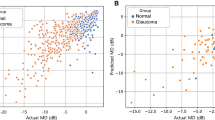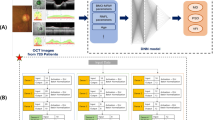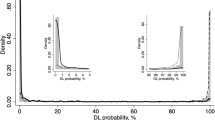Abstract
Background
To determine whether linear discriminant analysis (LDA) and artificial neural network (ANN) can improve the differentiation between glaucomatous and normal eyes in a Taiwan Chinese population, based on the retinal nerve fiber layer thickness measurement data from scanning laser polarimetry–variable corneal compensation (GDx VCC).
Methods
This study comprised 79 glaucoma (visual field defect, mean deviation: −5.60 ± 4.23 dB) and 86 healthy subjects (visual field defect, mean deviation: −1.44 ± 1.72 dB). Each patient received complete ophthalmological evaluation, standard automated perimetry (SAP), and GDx VCC exam. One eye per subject was considered for further analysis. The area under the receiver operating characteristics (AROC) curve, sensitivity, specificity and the best cut-off value for each parameter were calculated. The diagnostic performance of artificial neural network (ANN) and linear discriminant analysis (LDA) for glaucoma detection using GDx VCC measurements will be compared in this study.
Results
The individual parameter with the best AROC curve for differentiating between normal and glaucomatous eye was nerve fiber indicator (NFI, 0.932). The highest AROCs for the LDA and ANN methods were 0.950 and 0.970 respectively.
Conclusion
NFI, ANN and LDF method demonstrated equal diagnostic power in glaucoma detection in a Taiwan Chinese population.




Similar content being viewed by others
References
Bowd C, Chan K, Zangwill LM, Goldbaum MH, Lee TW, Sejnowski TJ, Weinreb RN (2002) Comparing neural networks and linear discriminant functions for glaucoma detection using confocal scanning laser ophthalmoscopy of the optic disc. Invest Ophthalmol Vis Sci 43:3444–3454
Bowd C, Medeiros FA, Zhang Z, Zangwill LM, Hao J, Lee TW, Sejnowski TJ, Weinreb RN, Goldbaum MH (2005) Relevance vector machine and support vector machine classifier analysis of scanning laser polarimetry retinal nerve fiber layer measurements. Invest Ophthalmol Vis Sci 46:1322–1329
Brusini P, Salvetat ML, Parisi L, Zeppieri M, Tosoni C (2005) Discrimination between normal and early glaucomatous eyes with scanning laser polarimeter with fixed and variable corneal compensator settings. Eur J Ophthalmol 15:468–476
Dash M, Liu H, Yao J (1997) Dimensionality Reduction of Unsupervised Data. Proceedings of the Ninth IEEE International Conference on Tools with AI (ICTAI'97), Newport Beach, CA, pp 532–539
DeLong ER, DeLong DM, Clarke-Pearson DL (1988) Comparing the areas under two or more correlated receiver operating characteristic curves: a nonparametric approach. Biometrics 44:837–845
Essock EA, Zheng Y, Gunvant P (2005) Analysis of GDx-VCC polarimetry data by Wavelet-Fourier analysis across glaucoma stages. Invest Ophthalmol Vis Sci 46:2838–2847
Garway-Heath D, Hitchings RA (1998) Sources of bias in studies of optic disc and retinal nerve fibre layer morphology. Br J Ophthalmol 82:986
Garway-Heath DF, Greaney MJ, Caprioli J (2002) Correction for the erroneous compensation of anterior segment birefringence with the scanning laser polarimeter for glaucoma diagnosis. Invest Ophthalmol Vis Sci 43:1465–1474
Greenfield DS, Knighton RW, Feuer W, Schiffman JC, Zangwill L, Weinreb RN (2002) Correction for corneal polarization axis improves the discriminating power of scanning laser polarimetry. Am J Ophthalmol 134:27–33
Haddad WM, Chellaboina VS, Nersesov S (2006) Thermodynamics: a dynamical systems approach. IEEE Transactions on Automatic Control 51:1217–1225
Hanley JA, McNeil BJ (1983) A method of comparing the areas under receiver operating characteristic curves derived from the same cases. Radiology 148:839–843
Huang ML, Chen HY (2005) Development and comparison of automated classifiers for glaucoma diagnosis using stratus optical coherence tomography. Invest Ophthalmol Vis Sci 46:4121–4129
Iester M, Jonas JB, Mardin CY, Budde WM (2000) Discrimination analysis models for early detection of glaucomatous optic disc changes. Br J Ophthalmol 84:464–468
Jonas JB, Budde WM, Panda-Jonas S (1999) Ophthalmoscopic evaluation of the optic nerve head. Surv Ophthalmol 43:293–320
Kleinbaum DG, Kupper LL, Muller KE (1998) Applied regression analysis and other multivariate methods, 2nd edn. PSW-Kent, Boston
Lambert FL (2002) A cracked crutch for supporting entropy discussions. J Chem Educ 79:187–192
Medeiros FA, Ng D, Zangwill LM, Sample PA, Bowd C, Weinreb RN (2007) The effects of study design and spectrum bias on the evaluation of diagnostic accuracy of confocal scanning laser ophthalmoscopy in glaucoma. Invest Ophthalmol Vis Sci 48:214–222
Medeiros FA, Susanna RJ (2003) Comparison of algorithms for detection of localized nerve fiber layer defects using scanning laser polarimetry. Br J Ophthalmol 87:413–419
Medeiros FA, Zangwill LM, Bowd C, Mohammadi K, Weinreb RN (2004) Comparison of scanning laser polarimetry using variable corneal compensation and retinal nerve fiber layer photography for detectionof glaucoma. Arch Ophthalmol 122:698–704
Poinoosawmy D, Tan JC, Bunce C, Hitchings RA (2001) The ability of the GDx nerve fiber analyzer neural network to diagnose glaucoma. Graefes Arch Clin Exp Ophthalmol 239:122–127
Quigley HA, Addicks EM, Green WR (1982) Optic nerve damage in human glaucoma III: quantitative correlation of nerve fiber loss and visual field defect in glaucoma, ischemic neuropathy, apilledema and toxic neuropathy. Arch Ophthalmol 100:135–146
Raimundo IM, Narayanaswamy R (2001) Simultaneous determination of relative humidity and ammonia in air employing an optical fibre sensor and artificial neural network. Sens Actuators B 74:60–68
Reus NJ, Lemij HG (2004) Diagnostic accuracy of the GDx VCC for glaucoma. Ophthalmology 111:1860–1865
Sommer A, Miller NR, Pollack I, Maumenee AE, George T (1977) The nerve fiber layer in the diagnosis of glaucoma. Arch Ophthalmol 95: 2149–2156
Tomatis S, Bono A, Bartoli C et al (2003) Automated melanoma detection: multispectral imaging and neural network approach for classification. American Association of Physicists in Medicine 2:212–221
Vapnik V (2000) The Nature of Statistical Learning Theory, 2nd edn. Springer, New York
Weinreb RN, Bowd C, Zangwill LM (2003) Glaucoma detection using scanning laser polarimetry with variable corneal polarization compensation. Arch Ophthalmol 120:218–224
Weinreb RN, Zangwill L, Berry CC, Bathija R, Sample PA (1998) Detection of glaucoma with scanning laser polarimetry. Arch Ophthalmol 116:1583–1619
Acknowledgments
The authors would like to thank for the National Science Council of the Republic of China for financially supporting this research under Contract No. 97-2628-E-167-001-MY3& DMR-93-046, DMR-94-043.
Author information
Authors and Affiliations
Corresponding author
Additional information
The authors have full control of all primary data, and we agree to allow Graefe's Archive for Clinical and Experimental Ophthalmology to review our data.
Commercial relationships policy: N
Rights and permissions
About this article
Cite this article
Huang, ML., Chen, HY., Huang, WC. et al. Linear discriminant analysis and artificial neural network for glaucoma diagnosis using scanning laser polarimetry–variable cornea compensation measurements in Taiwan Chinese population. Graefes Arch Clin Exp Ophthalmol 248, 435–441 (2010). https://doi.org/10.1007/s00417-009-1259-3
Received:
Revised:
Accepted:
Published:
Issue Date:
DOI: https://doi.org/10.1007/s00417-009-1259-3




